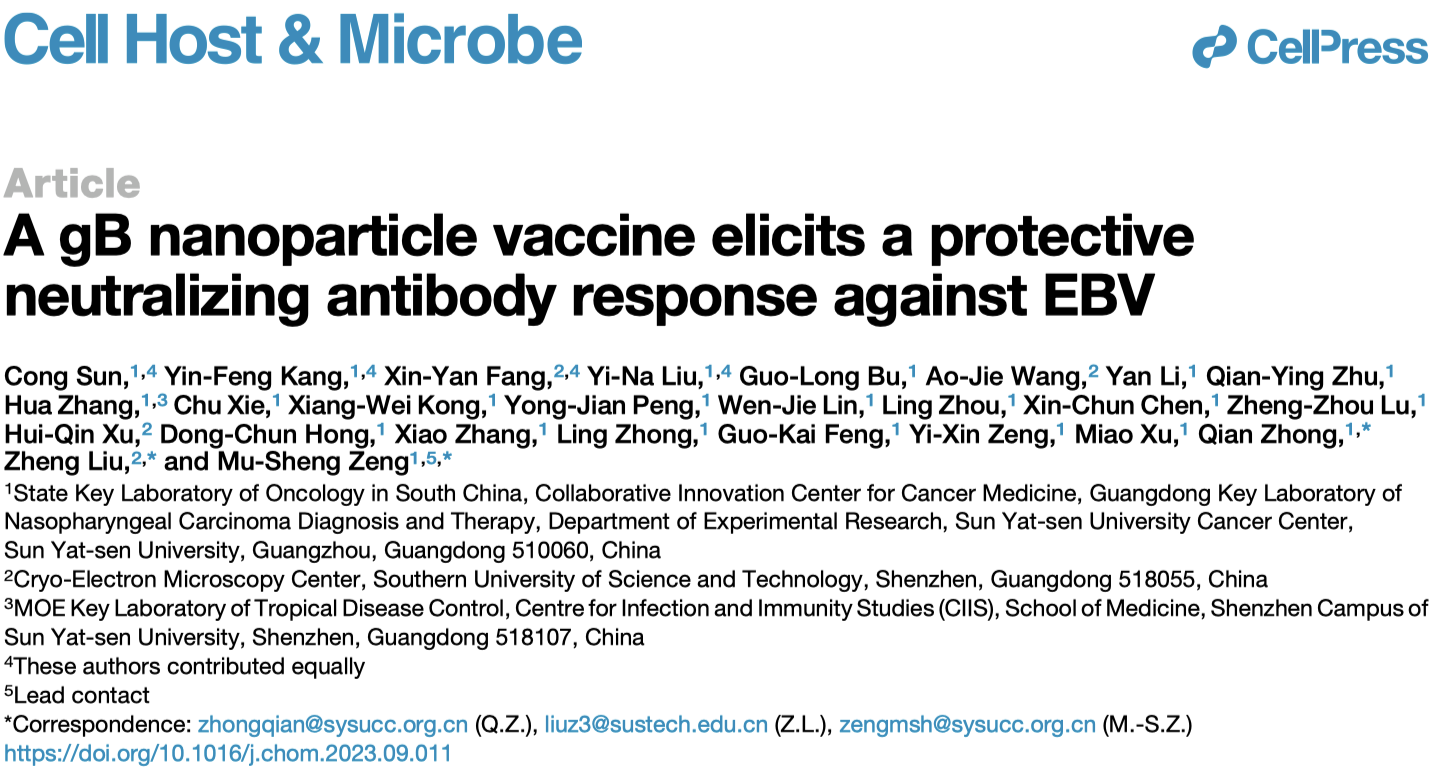The Epstein-Barr virus (EBV) is a widely susceptible human herpesvirus. It's a double-stranded DNA-enveloped virus and the first human tumor virus discovered. It's the pathogen causing infectious mononucleosis (IM) and is associated with nasopharyngeal carcinoma, certain gastric cancers, various lymphomas, and autoimmune diseases like multiple sclerosis. However, to date, there's no preventive vaccine available for EBV worldwide. The virus membrane of EBV contains multiple viral glycoproteins that, by binding to their corresponding receptors, collectively mediate viral infection of host cells. Among these, the key glycoprotein gB is the fusion protein of the virus, capable of binding to the virus receptor on the cell membrane and receiving signals from other viral glycoproteins, triggering the fusion of the virus with the cell membrane. Previous work by Professor Zeng’ s team identified that EBV and KSHV virus gB could recognize the NRP1 receptor, laying an important foundation for gB as an antigen. Although gB is a potential ideal vaccine target for EBV, its weak activation of humoral immunity, short duration of immune effects, and insufficient induction of neutralizing antibodies hinder its further research and application as a vaccine.

On October 16, 2023, Professors Mu-Sheng Zeng and Qian Zhong from Sun Yat-sen University Cancer Center, along with Professor Zheng Liu from Southern University of Science and Technology, published their research results titled 'A gB nanoparticle vaccine elicits a protective neutralizing antibody response against EBV' in the journal Cell Host & Microbe. They computationally designed and expressed a nanoparticle vaccine that displays gB on its surface, demonstrating its high efficiency in inducing the production of neutralizing antibodies against EBV while maintaining good antigenicity and stability, thus laying a crucial foundation for the development of future EBV vaccines.
In this study, the researchers first computationally docked gB with several different nanoparticle scaffold proteins to determine the optimal spacing for linking. Based on the computational model, they designed the gB-presenting nanoparticle, gB-I53-50 NP, and through in vitro assembly and biochemical and structural biology verification, confirmed successful expression of the nanoparticle displaying EBV's gB protein on its surface.
Subsequently, using techniques like intrinsic protein fluorescence scanning and biofilm interference, the researchers established that this vaccine not only enhances the antigenicity of gB but also exhibits remarkable structural stability. Moreover, the nanoparticle showed good stability at 4°C and room temperature, laying a crucial stability foundation for vaccine preparation and transport.
Through immunization experiments on mice and non-human primates, the researchers found that this vaccine, while maintaining good immunological safety, is more efficient than traditional subunit protein vaccines in inducing neutralizing antibodies against EBV. It also inhibits infection of EBV epithelial cells and B cells while inducing stronger T-cell activation and cytotoxicity. Furthermore, using a humanized mouse model, researchers found that the gB nanoparticle vaccine-induced serum polyclonal antibodies significantly protected humanized mice from EBV infection and lymphoma development. This protective effect persisted even 10 weeks after primate immunization, confirming the vaccine's strong and long-lasting neutralizing protective antibody effects.
In summary, the study demonstrates that through computer-aided design, it's possible to develop a gB nanoparticle protein (gB-I53-50 NP) with the ability to efficiently induce strong neutralizing protective antibodies. This nanoparticle not only possesses high overall structural and antigenic stability but also exhibits superior antigenicity and outstanding immunogenicity, displaying excellent antibody induction capabilities and remarkable antibody protective effects in multiple animal models. Hence, this protein nanoparticle vaccine stands as a next-generation candidate vaccine for EBV with significant clinical translational potential and provides important insights for the development of vaccines against other pathogenic herpesviruses.
Professors Mu-Sheng Zeng from Sun Yat-sen University Cancer Center, Zheng Liu from the Cryo-Electron Microscopy Center of Southern University of Science and Technology, and Qian Zhong from Sun Yat-sen University Cancer Center are the co-corresponding authors of this paper. Dr. Cong Sun from Sun Yat-sen University Cancer Center, Dr. Yin-Feng Kang from Sun Yat-sen University Cancer Center, Ph.D. candidate Xin-Yan Fang from Southern University of Science and Technology, and Dr. Yi-Na Liu from Sun Yat-sen University Cancer Center are the co-first authors of this paper. This research received important assistance from Professor Maria Masucci from Karolinska Institute in Sweden and Professor Neil P. King from the University of Washington. The study was supported by grants from the National Natural Science Foundation of China and the National Key Research and Development Program.
Link to the original article: https://doi.org/10.1016/j.chom.2023.09.011
